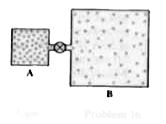PROBLEMS from RESNICK AND HALLIDAY PHYSICS (HINGLISH) THE KINETIC THEORY OF GASES for Class 12
| Class 12 | PHYSICS |
| Chapter | THE KINETIC THEORY OF GASES |
| RESNICK AND HALLIDAY PHYSICS (HINGLISH) | PROBLEMS |
| Medium | English |
| Academic Year | 2023-2024 |
Question 4
Water standing in the open at 10.0°C evaporates because of the escape of some of the surface molecules. The heat of vaporization (539 cal/g) is approximately equal to en, where e is the average energy of the escaping molecules and n is the number of molecules per gram. (a) Find ε. (b) What is the ratio of ε to the average kinetic energy of H2O molecules, assuming the latter is related to temperature in the same way as it is for gases? View SolutionQuestion 6
A beam of hydrogen molecules (H2) is directed toward a wall, at an angle of 32∘ with the normal to the wall. Each molecule in the beam has a speed of 1.0 km/s and a mass of 3.3×10−24 g. The beam strikes the wall over an area of 2.0 cm?, at the rate of 4.0×1023 molecules per second. What is the beam's pressure on the wall? View SolutionQuestion 9
Suppose 10.0 g of oxygen (O2) gas is heated at constant atmospheric pressure from 25.0∘C to 125∘C. (a) How many moles of oxygen are present? (See Table 20-1 for the molar mass.) (b) How much energy is transferred to the oxygen as heat? (The molecules rotate but do not oscillate.) (c) What fraction of the heat is used to raise the internal energy of the oxygen?View SolutionQuestion 12
Water bottle in a hot car. In the American Southwest, the temperature in a closed car parked in sunlight during the summer can be high enough to burn flesh. Suppose a bottle of water at a refrigerator temperature of 5.00∘C is opened, then closed, and then left in a closed car with an internal temperature of 65.0∘C. Neglecting the thermal expansion of the water and the bottle, find the pressure in the air pocket trapped in the bottle. (The pressure can be enough to push the bottle cap past the threads that are intended to keep the bottle closed.) View SolutionQuestion 14
A container encloses 1.5 mol of an ideal gas that has molar mass M, and 0.50 mol of a second ideal gas that has molar mass M, 3.0M What fraction of the total pressure on the container wall is attributable to the second gas? (The kinetic theory explanation of pressure leads to the experimentally discovered law of partial pressures for a mixture of gases that do not react chemically: The total pressure exerted by the mixture is equal to the sum of the pressures that the several gases would exert separately if each were to occupy the vessel alone. The molecule-vessel collisions of one type would not be altered by the presence of another type.) View SolutionQuestion 15
Container A in holds an ideal gas at a pressure of 8.0×105 Pa and a temperature of 250 K. It is connected by a thin tube (and a closed valve) to container B, with four times the volume of A Container B holds the same ideal gas at a pressure of 1.0×105 Pa and a temperature of 450 K. The valve is opened to allow the pressures to equalize, but the temperature of each container is main tained. What then is the pressure?
 View Solution
View SolutionQuestion 19
Submarine rescue. When the U.S. submarine Squalus became disabled at a depth of 80 m, a cylindrical chamber was lowered from a ship to rescue the crew. The chamber had a radius of 1.00 m and a height of 3.50 m, was open at the bottom, and held two rescuers. It slid along a guide cable that a diver had attached to a hatch on the submarine. Once the chamber reached the hatch and clamped to the hull, the crew could escape into the chamber. During the descent, air was released from tanks to prevent water from flooding the chamber. Assume that the interior air pressure matched the water pressure at depth h as given by P0+ρgh, where P0 = 1.000 atm is the surface pressure and p= 1024 kg/m3 is the density of seawater. Assume a surface temperature of 20.0°C and a submerged water temperature of −40.0∘C. (a) What is the air volume in the chamber at the surface? (b) If air had not been released from the tanks, what would have been the air volume in the chamber at depth h = 80.0 m? (c) How many moles of air were needed to be released to maintain the original air volume in the chamber?View SolutionQuestion 20
An air bubble of volume 15 cm is at the bottom of a lake 40 m deep, where the temperature is 4.0∘C. The bubble rises to the surface, which is at a temperature of20∘C Take the temperature of the bubble's air to be the same as that of the surrounding water. Just as the bubble reaches the surface, what is its volume?View Solution


